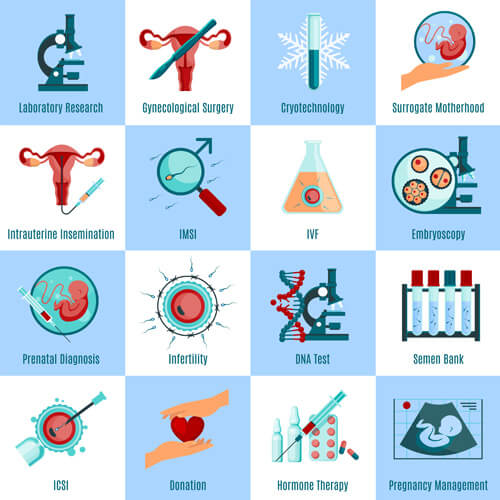Surrogacy – Surrogate Mother
Table of Contents
What is surrogacy?
Surrogacy is the process of transferring the eggs of the woman who does not have suitable conditions for pregnancy or does not want to be involved in the pregnancy process, and the sperm cells of the man, after they are fertilized under laboratory conditions, to another woman. With this method, the person carrying the baby of the woman or the couple is called a surrogate mother. For surrogacy, it is not mandatory for couples to always use their own sperm and eggs. Babies born through this method carry the genetic characteristics of both the mother and the father. Therefore, the baby is genetically similar to its parents. People who prefer surrogacy are included in the IVF treatment process.Some women provide professional surrogacy services in return for a certain agreement. If such a request is not made, close friends, relatives or family members can also be a surrogate mother. In order to find the ideal surrogate mother, it is always recommended to be in a coordinated process with a professional team.
There are two different types of Surrogacy. Partial surrogacy is when the surrogate mother is simultaneously the biological mother of the child. In this method, the eggs taken from the surrogate mother are fertilized with the sperm obtained from the father or the donor through the inoculation method. Full surrogacy is the situation in which the child has no biological relationship with the surrogate mother and she gets pregnant with in vitro fertilization treatment without any biological relationship with the surrogate mother. This process is based on the principle of creating an embryo through the sperm and egg taken from the mother, father, donor mother or donor father and transferring the embryo to the womb of the surrogate mother.
The surrogacy process applied in the Turkish Republic of Northern Cyprus is carried out together with specialist doctors and a professional team. With this method, which has achieved world-class success, the chance of having a baby is quite high. The process, which is carried out in modern laboratories and by experienced teams in technical equipment, includes personalized treatment programs. Risk factors that may occur are determined in advance, and control procedures are created for all factors that reduce the chance of success.

Who can benefit from surrogacy?
In order to benefit from surrogacy, it is sufficient not to have the conditions for giving birth to a child for certain reasons or not being willing to be involved in the pregnancy process. These conditions are;
How is the pregnancy process of the surrogate mother? How does a surrogate mother get pregnant?
In order for the surrogate mother to be included in the pregnancy process, she must first have certain characteristics. These features are;
For the surrogate motherhood process, the expectant mother is subjected to comprehensive examination applications such as gynecological examinations, tests and analyzes as in the IVF treatment process. The menstrual cycle is planned to have the uterus prepared for the pregnancy process. Ultrasound examinations are performed at certain intervals. Embryo transfer is performed when ready. Optionally, frozen embryos can also be transferred. In the absence of a frozen embryo, the treatment process of the couple is carried out together with the internal uterus preparation of the surrogate mother and the fertilized embryos are transferred within a suitable time under laboratory conditions.
Surrogacy begins on the 2nd or 3rd day of the menstrual cycle. In the first phase of the egg stimulation program, which takes an average of 10 to 12 days, oocyte retrieval is performed. Then followa the step of fertilization of the eggs with sperm. After the developmental status of the embryos is observed, the relevant embryos are transferred to the surrogate mother on the most appropriate day.

In the Turkish Republic of Northern Cyprus, it is also possible to create a photo and text profile together with experts to speed up and facilitate the matching process in the surrogacy application carried out.Optionally, there can be a communication with the surrogate mother after the matching. Similarly, it is possible for the surrogate mother to create a profile in order to get to know more closely the couples who apply for the application.
What are the medical risks of surrogacy?
The risks in surrogacy are similar to the risks that may be encountered in IVF treatment. Due to the transfer process of the embryo, the influence of the environment in which it is cultured, etc. undesirable results may occur. Transferring more than one embryo to increase the chances of implantation may cause complications for the surrogate mother and the embryos.
Compared to mothers who became pregnant with oocyte donation during the birth process.The risk of high blood pressure (hypertensive disorder) is lower in the surrogacy application, which is preferred by women who have ovulation function, which is called the gestational method, but do not have the ability to continue the pregnancy. The possible reason for this situation is that surrogate mothers are healthier than women who use oocyte donation within the scope of fertility criteria.
Again, in IVF treatment, there is a risk of encountering some medical abnormalities in children born with IVF surrogacy, that are not seen during the natural conception process. When children born by IVF method are compared with those born by surrogacy, both methods have similar birth defect rates. However, with the test and diagnosis carried out in the clinical environment before the process,this situation is reduced to a minimal risk level and by this means a healthy birth, healthy child is aimed.



